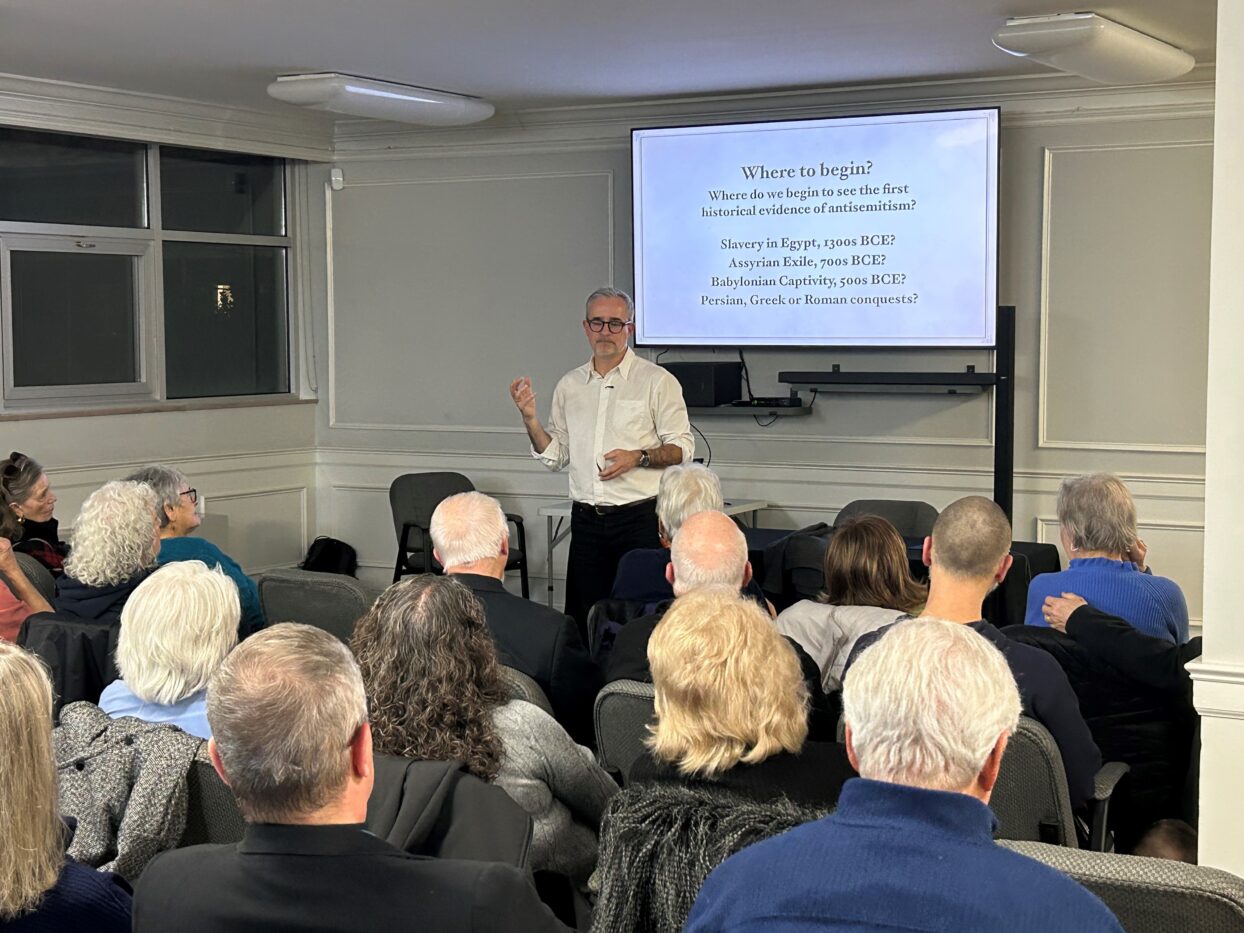By Bill Brewer
Why the Jews?
It’s a question that has been asked for thousands of years and one that took on renewed significance Oct. 7 when Hamas attacked Israel, provoking Mideast fighting that continues and threatens to spread.
And it’s a question that Catholic educator Brendan Murphy has resolved to answer in his teachings on the history of antisemitism.
Mr. Murphy teaches at Marist School, a Catholic college preparatory institution in Atlanta. The private, independent school was founded by the Society of Mary, or Marists, in Atlanta in 1901 and is the oldest Catholic secondary school in the Georgia capital.
As antisemitism rears its head in communities around the world, including on U.S. college campuses, Mr. Murphy is presenting years of research into the origins of antisemitism and the history of the Holocaust to audiences around the region.
Among the most recent audiences to witness his insight was one in Chattanooga on Jan. 24.
In a program titled “Let’s Talk! The journey of friendship between Jews and Catholics in Chattanooga,” which was hosted by the Mizpah Congregation, a Reform Jewish community, at the Julius and Bertha Ochs Temple on McCallie Avenue, some 100 East Tennessee Jews and Christians listened to Mr. Murphy’s two-hour presentation.
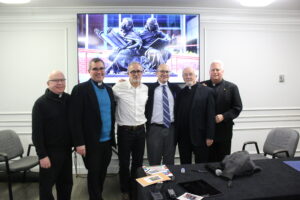
From left, Father Jim Vick, Father Peter Iorio, Brendan Murphy, Rabbi Craig Lewis, Monsignor Al Humbrecht, and Father Mike Nolan join together on Jan. 24 at the Julius and Bertha Ochs Temple in Chattanooga following Mr. Murphy’s presentation about Jewish-Christian relations and antisemitism. (Photo Dan McWilliams)
Breaking bread
In a show of unity and Jewish-Christian partnership, Mizpah Congregation Rabbi Craig Lewis joined Monsignor Al Humbrecht, pastor of Holy Spirit Parish in Soddy-Daisy, in organizing the program. Diocese of Knoxville priests Father Mike Nolan, Father Jim Vick, and Father Peter Iorio also participated in the program. Father Nolan is pastor of St. Thérèse of Lisieux Parish in Cleveland; Father Vick is pastor of St. Bridget Parish in Dayton; and Father Iorio is pastor of Our Lady of Fatima Parish in Alcoa.
The Mizpah Congregation is one of several Jewish communities in Chattanooga. Others are Chabad Jewish Center, which is the orthodox congregation, B’Nai Zion Congregation, which is the conservative congregation, and the Jewish Federation of Greater Chattanooga, a communal group.
The Diocese of Knoxville has a number of parishes in the Chattanooga area, including the Basilica of Sts. Peter and Paul, Our Lady of Perpetual Help, St. Jude, St. Stephen, St. Augustine, Shepherd of the Valley, Our Lady of Lourdes, St. Bridget, Holy Spirit, and St. Thérèse of Lisieux.
Mr. Murphy delved into antisemitism’s roots that date to the early years of recorded biblical history, and he explored how myths about Judaism have been perpetuated through time, contributing to the spread of antisemitism, including by Catholics.
Images he shared were from Nazi Germany and the Holocaust as well as religious icons, some of which still exist.
One image in particular prompted discussion by Mr. Murphy and audience members. Ecclesia and Synagoga are Christian-sculpted figures personifying the brokenness between Christianity and Judaism. In medieval-period works of art, Ecclesia and Synagoga are typically side by side and depicted as young and attractive, with Ecclesia representing Christianity, adorned with a crown, chalice, and a cross-topped staff, looking confidently forward.

Audience members listen intently to Brendan Murphy’s presentation about the history of Judaism and antisemitism. (Photo Dan McWilliams)
In contrast, a separate Synagoga, representing Judaism, is blindfolded, stooped, carrying a broken staff, and has the Torah slipping from her hand.
On Catholic churches around the world, Ecclesia and Synagoga can be found within their architecture, often in high-profile positions, such as near church entrances.
Mr. Murphy cited early depictions of this personification of the Church and Judaism as instances of antisemitism that help perpetuate destructive myths about the Jewish faith.
He then pointed to the Second Vatican Council and its historic document Nostra aetate, Pope St. John Paul II and his 2000 visit to Israel, and subsequent visits to Israel by Popes Benedict XVI and Francis as examples of ways the Catholic Church is now supporting the Jewish faith and is seeking to forge an enduring relationship.
Reversing the record
It is Mr. Murphy’s hope—indeed his prayer—that the Catholic Church and all of Christianity reverse the negative record on Judeo-Christian relations, especially as it relates to antisemitism. He sees school systems, whether primary, secondary, or university, as a catalyst for that reversal.
“The awareness of the history of antisemitism varies among individuals and can be influenced by several factors. The depth and coverage of historical topics, including antisemitism, can vary in educational curricula. Some educational systems may not provide comprehensive coverage of this history, leading to gaps in knowledge. Individuals who have not had exposure to diverse historical perspectives or who have not engaged with relevant literature may not be aware of the history of antisemitism. Limited exposure to different cultures and historical events can contribute to ignorance on this topic,” Mr. Murphy said.
Mr. Murphy has been at Marist School for 30 years and teaches history. As part of his curricula, he teaches a seminar class on the Holocaust and world history. He also is the director of Peace by Piece, an interfaith dialogue club with Jews, Christians, and Muslims.
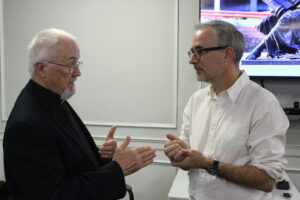
Monsignor Al Humbrecht, pastor of Holy Spirit Parish in Soddy-Daisy, and Mr. Murphy, a historian and speaker on the Holocaust and antisemitism, share ideas following Mr. Murphy’s talk in Chattanooga on Jan. 24. (Photo Dan McWilliams)
His work has been recognized around the country. Awards in education he has received include the Outstanding Educator Award from the Anne Frank Center in New York; the Anti-Defamation League’s Abe Goldstein Human Relations Award and Unsung Hero Award; Marist School’s Goizueta Chair of Excellence Award, the Faber-McKinley-Stadler Award, and the Frank Hagan Memorial Award; the Distinguished Service Award from the Georgia Independent School Association; the Educator of the Year by the University of Notre Dame; and in 2009 and 2016 the Georgia Outstanding Educator of the Year by the Georgia Commission on the Holocaust.
Mr. Murphy also is a Museum Teacher Fellow at the U.S. Holocaust Memorial Museum in Washington, D.C., and a Lerner Fellow at the Jewish Foundation for the Righteous in New York.
The longtime educator and graduate of the University of Notre Dame credits the Catholic Church in recent decades and its adoption of Nostra aetate and recognition of Judaism as a sister faith for helping to heal wounds.
Mr. Murphy said his Jewish audiences have responded “very positively” to his presentations. The Catholic portion of the audience in Chattanooga also responded positively, but Mr. Murphy acknowledged that Christian audiences can be caught off-guard by the low-profile, historic truths his program reveals.
“It can be a devastating shock for Christian audiences to confront the long and tragic history of Christian anti-Judaism. But they are grateful to do so,” he observed.
Does Mr. Murphy believe Christendom will accept the retracing of antisemitism history in his lifetime?
“Yes. Most Christian denominations are confronting the history of Christian anti-Judaism in a meaningful way,” he noted.
Monsignor Humbrecht was “very pleased” with Mr. Murphy’s talk.
“Again, we can’t deny history. But we can also see where we can learn from history and move beyond that,” Monsignor Humbrecht said. “Here in Chattanooga, we have always had good relationships between the Jewish and Catholic communities.”
Monsignor Humbrecht acknowledged periods of antisemitism within the Catholic Church throughout history that Mr. Murphy highlighted.
“It is part of our history. And to deny it doesn’t serve any good purpose. We have to build on the truth,” the Holy Spirit Parish pastor said.
Monsignor Humbrecht partnered with Rabbi Lewis and Jed Mescon, a Chattanooga broadcast personality who is a member of the Mizpah Congregation, in organizing the “Let’s Talk!” program.
While the program dealt with the dark days of antisemitism through the years leading up to the Holocaust, and a number of hard truths were exposed, Monsignor Humbrecht was inspired by the high note on which the presentation ended.
“Each part had its own role to play, but I loved the fact that it ended on such a positive note on here is where we are now and how we go from here,” Monsignor Humbrecht said.
Mr. Murphy pointed out that while periods of antisemitism in the Catholic Church furthered a divide between Judaism and Christianity, Pope John Paul II did much to heal those wounds when he visited Israel and the Western Wall, also known as the Wailing Wall, in Jerusalem in March 2000.
In Israel, the Holy Father took part in a historic ceremony in the Hall of Remembrance inside The World Holocaust Remembrance Center to express a wish for reconciliation between the Catholic Church and the Jewish people.
While praying at the Western Wall, Pope John Paul II placed a personal note in the wall between the stones that was a prayer for forgiveness and a wish for reconciliation. It said:
“God of our fathers, you chose Abraham and his descendants to bring your name to the nations. We are deeply saddened by the behavior of those who in the course of history have caused these children of yours to suffer, and asking your forgiveness, we wish to commit ourselves to genuine brotherhood with the people of the covenant. Amen.”
Also praying at the Western Wall in recent years were Pope Benedict XVI, Pope Francis, and Cardinal Timothy Dolan, archbishop of New York.
And having as great an impact or greater on Judeo-Catholic relations, according to Monsignor Humbrecht, has been Nostra aetate, which is considered an important declaration on the Church’s relationship with Jews and Muslims that pays special attention to the Judeo-Catholic relationship.
“In Nostra aetate, there was such a history with the cardinals at the council (Vatican II) trying to come together on how to phrase and what to bring out. It was a working process, but it turned out to be an extremely beautiful document,” Monsignor Humbrecht said.
Proponents of Nostra aetate would like to see it get the attention other, higher-profile Vatican II documents have received.
Rabbi Lewis said Mr. Murphy first delivered his presentation to the Mizpah Congregation during spring 2023, which he described as “captivating.”
“One of the questions that we asked was how much is this topic talked about in Catholic churches, in the Catholic schools. Brendan’s response was basically that it’s not enough. We then started talking about cooperating and coordinating with a Catholic church in the area, in our community, to partner and bring Brendan back again. Father Al (Humbrecht) was so gracious to work with us and do that,” Rabbi Lewis said, crediting volunteers along with Monsignor Humbrecht to bring about the program.
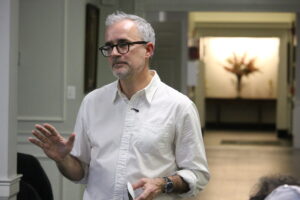
Historian and speaker Brendan Murphy gives a talk to nearly 100 people in Chattanooga about the history of antisemitism and hatred of Jews throughout world. (Photo Dan McWilliams)
Beginning the dialogue
Rabbi Lewis noted that representation from the Jewish and Catholic congregations at the presentation was good.
“We were delighted to see the turnout by the Catholic community and members of the general Christian community,” he said.
What does Rabbi Lewis hope the audience’s takeaway from the presentation is?
“Responsibility to know history and to share the story of what can happen when we teach the wrong message and what needs to happen when we can teach a better message, the right message of not hating without cause, of not fabricating falsehoods about other people simply because they are different, or simply because they are vulnerable, or simply because they can be scapegoated. Jewish history has taught us that when antisemitism has reared its head toward us, hatred is likely to fall upon other groups as well,” he said.
“So, part of our responsibility is to teach the history so that other people will stop oppressing, not just us, but just stop oppressing in general,” he added.
He doesn’t believe that is too tall of an order.
“It can’t be too tall. They can’t give us too much work to do. We certainly, collectively as the human race, have done our share to work the other way, to destroy. If we can work to destroy, we can certainly work together to build,” Rabbi Lewis pointed out.
“It’s painful to watch what’s going on in Israel and in Gaza. It’s very, very hard to watch and understand. But it reminds us why Israel is a necessity in the modern world because it was born out of the ashes of the Holocaust. And having a safe haven that will take in Jews from anywhere around the world when antisemitism threatens them, or threatens to expel them, offers them a place to go. And it’s a place that is a Jewish state and stands up for the Jewish people. It’s very clear why it’s there, and when its borders are threatened and attacked so viciously, Jews around the world feel vulnerable again.
“We don’t always agree on what the solution is. But we all understand that Israel was our answer to antisemitism. And that safety and protection has been pierced in such a way that we can’t rest until the land is safe and secure again,” the rabbi shared.
Rabbi Lewis learned from his history teachers that antisemitism and the hatred of Jewish people has never really gone away, it’s always been just below the surface.
“It’s just that certain world events happen, and then it becomes more exposed. The Anti-Defamation League frequently talks about antisemitism being the canary in the coal mine for all other sorts of hatreds to arise, which again gives us that extra responsibility to alert the rest of the world that as we’re being singled out, other groups will follow. It’s just so important that people be aware of hatred without cause,” he shared.
Rabbi Lewis is hopeful for a solution. In fact, he’s hopeful for enduring peace for all of Judaism.
“There has to be hope. Hope is what inspires life. If you can’t hope for something, then why do we get up and do what we do every day? Even to sustain ourselves, to feed ourselves, to raise our children means that we’re hoping for the future to be bright, brighter than it is now. The act of living is an act of hope. If we don’t have hope, then we just give in,” he said.
Rabbi Lewis said Mr. Murphy’s presentation gives him hope that people are willing to learn. But will there be enough of them?
“Yes, it gives me hope that people have an open mind. But we can’t paint anybody with a broad, sweeping brush to say that all Christians are coming around. There’s ample evidence of people of all faiths around the world keeping a closed mind and believing that their way is the right way, and therefore everybody else is wicked,” he said.
“There’s never enough. And this isn’t just about the Christian community. People in general need to be willing to open their eyes to understand that there is a multiplicity of ways of understanding our connection to God, our connection to the universe, and our responsibility within it. But just because we disagree doesn’t mean that we need to attack and vilify each other,” he continued.
Inspired to act
Father Nolan said members of his parish who attended the program were inspired, possibly to the point of taking action. “Not only inspired, but what can we do in our parish? How can we spread the word?”
He hopes his parishioners will indeed be inspired to act.
Father Vick agreed with Mr. Murphy that learning about antisemitism in the Catholic Church can be difficult to understand for older Catholics who were never taught this.
“They have to understand the connection about what they learned then (1940s-1950s) to now. Now they realize, so that’s what’s going on. They also learned something more important. There’s hope. Jews and Christians can come together, symbolized by that statue (“Synagoga and Ecclesia in Our Time”). That’s what was so amazing for them because it touched their hearts,” Father Vick said.
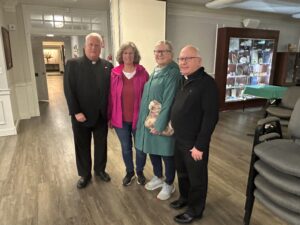
Joining Father Mike Nolan, left, and Father Jim Vick, right, were Beverly Short, center left, and Deidre Diener. Ms. Short is a member of Our Lady of the Mount Parish in Lookout Mountain, Ga., and Ms. Diener is a member or Our Lady of Perpetual Help Parish in Chattanooga. (Photo Bill Brewer)
At a time when antisemitism in society shows little sign of abating, the Diocese of Knoxville priests believe now is as good a time as any to have discussions among congregations and faiths.
“It takes a conversation. It takes forgiveness and mutual reconciliation. Put the cards on the table. Face the facts. Then walk together,” Father Vick suggested.
Father Nolan shared that he is learning new lessons, too.
“As a child, I never read Nostra aetate. I was 5 years old when it was introduced. I don’t know if any of my teachers ever read it. But even as a little boy growing up in East Ridge and attending Our Lady of Perpetual Help elementary school, we were taught that the Jews were our grandparents in the faith and we should respect and revere them,” Father Nolan said. “I think it bears repeating. This isn’t a new idea of the hope and the covenant. That statue (“Synagoga and Ecclesia in Our Time”) is phenomenal. I wasn’t even aware of some of the atrocities that he (Mr. Murphy) spoke of. But we’re families in the faith. Amen.”
Deidre Diener and Beverly Short were among the Catholics in the audience. Ms. Diener lives in Chattanooga and attends Our Lady of Perpetual Help Church. Ms. Short is in the Archdiocese of Atlanta and attends Our Lady of the Mount Church in Lookout Mountain, Ga.
The women were inspired to continue praying for peace and reconciliation among the faiths.
“I’m just a big proponent of hoping and praying for peace in the world. And I think education is the best way to make people aware of the history. Listening to (Mr. Murphy’s) explanations through the Bible with Jewish people and Christian people in the same room, I’m leaving with a sense of hope that this can be possible,” said Ms. Diener, who formerly lived in Knoxville and attended St. John XXIII Catholic Center on the University of Tennessee campus and taught at St. Joseph School.
“When I saw Pope John Paul II (images) at the Wailing Wall and putting his prayer in the wall and asking for forgiveness, that is a big step. Forgiveness is a necessary element that people need to become aware of and practice in order for us to have peace within ourselves and peace in our community,” Ms. Diener said. “I feel privileged to have been able to hear his (Mr. Murphy’s) talk.”
Ms. Diener enjoyed touring the synagogue where Mr. Murphy’s presentation was held, describing it as “absolutely beautiful.”
And she said she is praying for everyone in Israel and the Mideast as the fighting continues. “I just pray that people will wake up. But we must find peace within ourselves first.”
Ms. Short would like to see a series of presentations by Mr. Murphy be made available to people around the world.
She said she was among the many at the presentation hearing the history for the first time.
“I was in my late 20s before I even knew that Jesus was a Jew. I was talking with another lady, and she said she was in her 30s before she found out that Jesus was a Jew. So, I guess growing up in a Catholic church we weren’t taught that,” Ms. Short shared.
But she has learned from programs like Mr. Murphy’s and from members of the Jewish faith, and she is open to learning even more about Judeo-Christian history and the role of the Catholic Church.
While Ecclesia and Synagoga images have through history symbolized faiths at odds with each other, Mr. Murphy pointed to a U.S. artist who created a fresh look at the longtime religious relationship.
“Synagoga and Ecclesia in Our Time” was commissioned by St. Joseph University to celebrate a visit to the Philadelphia school in 2015 by Pope Francis, who was marking the 50th anniversary of Nostra aetate. The contemporary take on the historic symbols, created by Philadelphia sculptor Joshua Koffman, features a close relationship between Jews and Christians. It shows the two bronze figures sitting side by side holding their scriptures and appearing to be learning from each other.
Mr. Murphy was inspired by Mr. Koffman’s work. So much so that he persuaded Marist School to commission a replica of “Synagoga and Ecclesia in Our Time” for the Atlanta school’s campus.
Mr. Murphy sees the Koffman sculpture as the iconic future of Judeo-Christian relations.
“The sculpture has been an inspiration and a motivation for both Jews and Christians to better relations,” he said.
Mr. Murphy shared what he hoped would be his Chattanooga audience’s takeaway from his presentation. And it can apply to many other audiences as well.
“History often repeats itself, and understanding the historical patterns of antisemitism can help societies recognize early signs of discrimination and take steps to prevent its recurrence. Knowledge of past atrocities can serve as a warning and a call to action against any resurgence of antisemitic sentiments,” he concluded.

